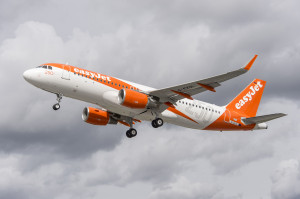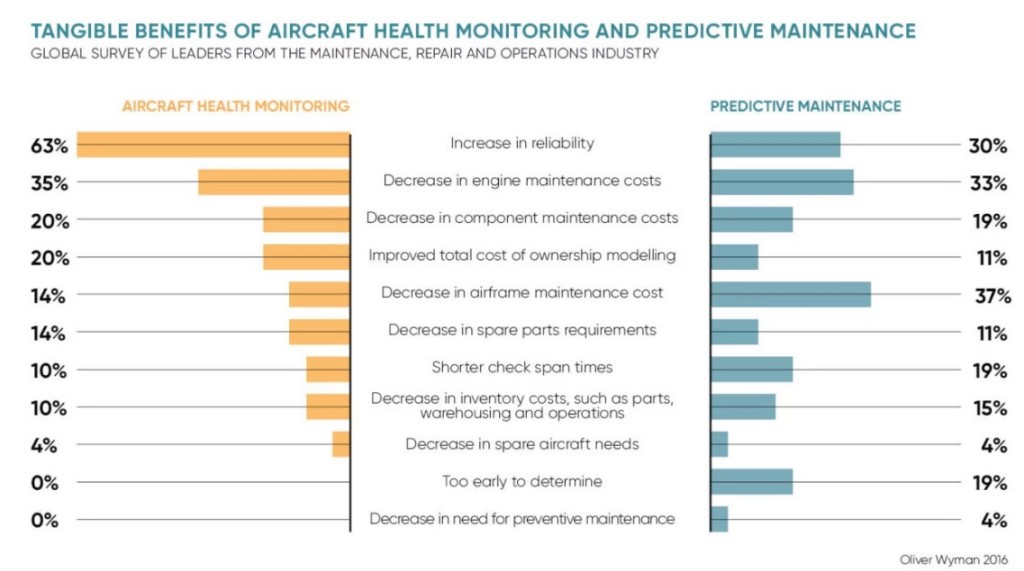EasyJet and Airbus Collaborate on ‘Big Data’ Integrated Vehicle Health Monitoring
In a project, first revealed in mid 2015, EasyJet and Airbus are collaborating on ‘big data’ Integrated Vehicle Health Monitoring (IVHM) technology.
At a SAE/RAeS/Cranfield University IVHM workshop Aerossurance participated in at the Farnborough International Airshow in July 2016, Ian Davies, EasyJet’s Head of Engineering & Technical Director commented how 20 years ago Health and Usage Monitoring Systems (HUMS) had become normal on offshore helicopters. The fixed wing sector is however he says still lagging behind (with the exception of engines were Engine Health Monitoring [EHM] has been routine for many years).
Previously Davies had commented that EasyJet wants to carry out early prognostics “just like Formula One”, which uses telemetry to predict when maintenance is needed.
At that time EasyJet, founded in 1995, had a fleet of 255 A319s and A320s across their UK and Swiss AOCs, which flew an average of 11.1 hours per day each in FY15, which is expected to expand to 350 in 3-5 years.
Even with 99.3% technical dispatch reliability they currently 7 aircraft dedicated as spare aircraft, and when the fleet reached 350 they would need 10, worth $800 million. So although the fixed wing sector may be lagging behind in IVHM application, the potential prize is massive.
EasyJet claim an engine In Flight Shut Down (IFSD) rate half of the average for the CFM56. However, although EHM has been in-use for years, they noted that they had 3 engines written off this year due to bearing failures, so their remain opportunities to improve EHM.
Davies identified one typical problem being that of avionic cooling fans, which when they fail generate smoke and odour in the cockpit that can prompt a precautionary landing. The addition of a vibration sensor could give prior warning of a deteriorating bearing.
At the SAE workshop it was said that two suppliers had been picked to demonstrate their solutions.
Airbus have previously been working with IBM on Airbus Smarter Fleet Solutions (ASFS):
…will integrate and also further develop Airbus’ current portfolio of software products (“e-solutions”). Presently, the latter comprise an extensive range of standalone applications…
…will provide tailored fleet data management using an open, modular and flexible platform. This service will give customers visibility to plan ahead for smooth operations. It will also enable them to easily integrate existing and new services…
“Today’s aircraft can generate up to a half terabyte of data per flight, an unprecedented volume and variety of data seen in few other industries,” said Timothy J. Wholey, Global Leader, Aerospace & Defense Industry, IBM Global Business Services.
Airbus has recently disclosed work with Californian data specialist Palantir: Airbus taps Silicon Valley expertise to speed production of A350:
Airbus began working with Palantir about 18 months ago, but has recently expanded the relationship…to eight projects across four countries…
Palantir’s staff worked with Airbus to tie together data from several different countries and databases, so that engineers spread across the company are better able to learn from each others’ experiences when fixing quality issues.
The secretive Palantir, which started out more than a decade ago working on national security projects, is valued at $20bn despite not yet delivering a profit.
The multimillion-dollar [A350] deal with Airbus would help it reach its planned target of profitability this year, said Alex Karp, chief executive. We did very well last year,” he said, including “moving towards profitability faster than we planned”.
UPDATE 26 February 2017: Palantir, co-founded by Peter Thiel in 2004, and allegedly active in intelligence projects, is expected to turn a profit this year.
https://youtu.be/yAJv0EvHt_I
UPDATE 26 May 2017: Data analysis is keeping planes flying
UPDATE 3 June 2017: Helicopter operators are increasingly data rich, but how much of it is producing value to safety, efficiency and effectiveness? In Big Data, Little Information, Mark Prior discusses how helicopter operators can extract more information from silos of data.
UPDATE 20 June 2017: Airbus has launched a collaboration with Palantir Technologies called Skywise.
At Paris Air Show press conference with the chief executive officers of AirAsia and ANA low-cost carrier Peach, plus recorded testimonials from easyJet’s Carolyn McCall and Emirates SVP engineering support Ahmed Safa, Airbus revealed that it is aiming to use big data not only to make its airline customers’ operations more efficient and productive, but to feed back into the design of the next generation of cabins and aircraft.
Skywise aims to…
…become the single platform of reference used by all major aviation players to improve their operational performance and business results and to support their own digital transformation. Skywise is already improving industrial operations performance throughout Airbus’ industrial footprint and allows now to deliver enhanced aircraft and equipment designs, better service and support offerings based on deeper in-service data insights.
https://youtu.be/D2o–8XzxrI
Skywise will provide all users with one single access point to their enriched data by bringing together to aviation data from multiple sources across the industry into one secure cloud-based platform.
These airline sources include:
- work orders
- spares consumption
- components data; aircraft / fleet configuration
- on-board sensor data
- flight schedules
Additional data sources which are traditionally shared will also be integrated:
- operational interruption history
- parts replacements
- post-flight reports
- pilot reports
- aircraft condition monitoring reports
- complete on-board aircraft data
- technical documentation
- technical requests
- service bulletins
Airbus say Skywise could help airlines by giving:
- Improved fleet operational reliability through predictive & preventative maintenance;
- Improved operational efficiency for legacy fleets;
- Rapid root-cause analyses of in-service issues;
- Optimising each aircraft’s performance through flight operations data analytics;
- Tracking maintenance effectiveness over time;
- One-click reporting workflows, including complex reporting to regulatory bodies.
With Skywise, operators of Airbus aircraft will be in a position to leverage the cumulative knowledge of the 20,000 Airbus engineers who have tracked the performance of each individual aircraft over its entire operational life. Until now, this deep reservoir of expertise was accessible only during the years of development and flight tests through the aircraft Entry-into-Service.
Marc Fontaine, the Airbus Digital Transformation Officer, said:
Together with Palantir, we are already realising major business value from data previously hidden within our own operations. Now with Skywise we are taking this relationship to the next level… We’ve seen its power in our own operations, and Airbus is convinced of its huge potential to bring value to our customers and industry partners, as the new ‘beating heart of aviation’.
Dr Alex Karp, CEO of Palantir Technologies commented:
Our relationship began with a focus on Airbus-internal operations – manufacturing, engineering, services – and we’re expanding now to bring this same analytical acumen directly to airlines. The potential…is unprecedented.
The deliverables will be tailored for each user.
UPDATE 10 August 2017: The UK AAIB issue a report on one of the potential IVHM target failures: Airbus A320-214 (G-EZTK), avionics fan failure causing vibration and fumes in the cockpit. In the cruise, between Paphos and Athens, 20 January 2017. The aircraft, en route from Paphos to London Gatwick “when the crew became aware of a sudden “whirring”
noise…accompanied by a distinct electrical burning smell in the cockpit”. The crew made a PAN call an initiated a diversion to Athens were they made an overweight landing.
Engineering fault diagnosis found the avionics bay cooling extractor fan to have seized as a result of bearing failure.
In this type of avionic bay fan, a bearing failure leads to damage to the stator, rotor and body of the fan with rubbing and friction. This manifests itself as a rumbling noise, with vibration and a frictional burning smell as experienced during this incident.
The aircraft operator continues to monitor fan life with an ongoing campaign targeting fans perceived as high risk, using criteria set by an analysis of in-service experience accompanied by manufacturer recommendations. To date, 82 of the 131 fans identified have been removed and overhauled. In addition, the operator will be participating in an in-service evaluation of a fan health monitoring unit. This equipment is designed to monitor vibration levels to give an early warning of possible bearing failure and to shut the fan down automatically when very high vibration is sensed to avoid critical failure that leads to smoke or burning smell events.
UPDATE 12 December 2017: Airbus sees big data delivering ‘zero-AOG’ goal within 10 years
Mathew Evans, vice-president of digital transformation programmes at Airbus, said he expected three distinct steps.
The first has already happened – we’re already using predictive maintenance as well as diagnostics and health monitoring to drive out the unscheduled events.
In a sense we are modifying the maintenance schedule, but modifying it by making it more frequent so we are avoiding AOGs and operational interruptions.
So around 2025 we will achieve that ‘zero-AOG’ goal where you can expect your aircraft to not ever be down because of a mechanical fault..
The second phase is also “fairly imminent” but will take some time to fully implement:
You’ll start to see certain components that have scheduled checks that don’t have to be done if there’s a base of data or base of monitoring that says the part is actually okay.
That third wave will be tough to get to, where you actually say that the aircraft maintenance manual is a dynamic document based entirely on that specific tail number, and every check and interval will be based on the operational history of that aircraft. That last step will only come when we’ve accumulated a lot of history, a lot of examples and a lot of confidence from a regulatory standpoint that we really understand the full scope of this.
UPDATE 27 March 2018: EasyJet signs Skywise Predictive Maintenance agreement with Airbus for its entire fleet
Aerossurance has undertaken a 2 year HUMS maintenance credit project for the UK Military Aviation Authority (MAA).
We have previously written: Helicopter HUMS Maintenance Credit: New Initiatives




Recent Comments